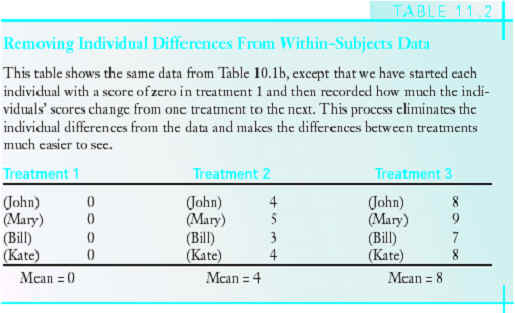
Psy 330
Experimental Designs: Within-Subjects Design
I. Characteristics of Within-Subjects Designs
Uses a single sample of individuals and tests each individual in all treatment conditions of the experiment
The "ultimate" equivalent groups design
Often called repeated-measures design

What does the repeated measures analysis look for?
II. Advantages
Fewer participants
Major advantage--eliminates all problems concerning individual differences
In what two ways were individual differences a problem for between-subjects designs?
--between groups--can become a confound by creating non-equivalent groups
--within groups--can create a lot of variability and obscure the treatment effect (if one exists)
These problems are reduced or eliminated in a within-subjects design


Ultimate goal: To be able to conclude that the differences between treatment conditions were caused by the treatment
Major advantage of within-subjects design: We can separate the variability due to individual differences from the rest of the variability
Can measure differences between treatments without involving any individual differences. Same participants are in every treatment condition, so treatment effects and the individual differences are not linked.
Can measure differences between individuals because individual differences are consistent across all treatments.
Process of separating individual differences--analyze amount of change from treatment to treatment


III. Disadvantages
Any factor allowing an alternative explanation for the research results is a threat to internal validity.
A. Time-Related Problems
History--events (other than the treatment) that occur any time between the first and last treatment condition and may affect the results.
Is the change in the DV caused by the IV or by outside events?
Maturation--any changes in physiology or psychology occurring during the experiment that are unrelated to the IV.
Really a problem when the treatments span a long period of time
Instrumentation--changes in the measurement instrument that occur over time
Statistical regression--extreme scores on one measurement tend to be less extreme on a second measurement
B. Order-Effect Problems
Carryover effects--participating in one condition produces a change in participants that affects their performance in subsequent conditions. (caused by experience in a particular treatment condition)
Progressive error--performance changes not because of the treatment but because of experience over time (caused by the general experience of participating in an experiment)
testing effects--changes in behavior that occur because the participant's behavior is measured repeatedly
Common types of progressive error--fatigue and practice effects


Choosing Within- or Between Subjects Design
1. Individual Differences
2. time-related and order effects
3. Fewer participants